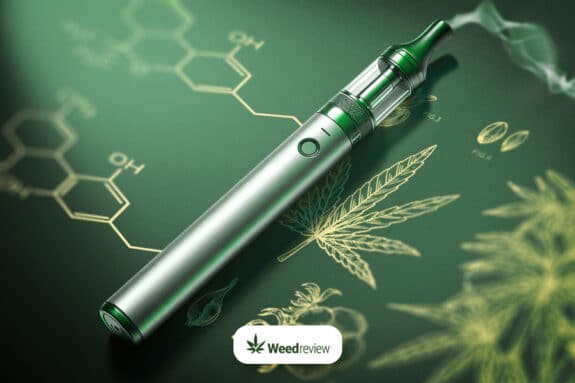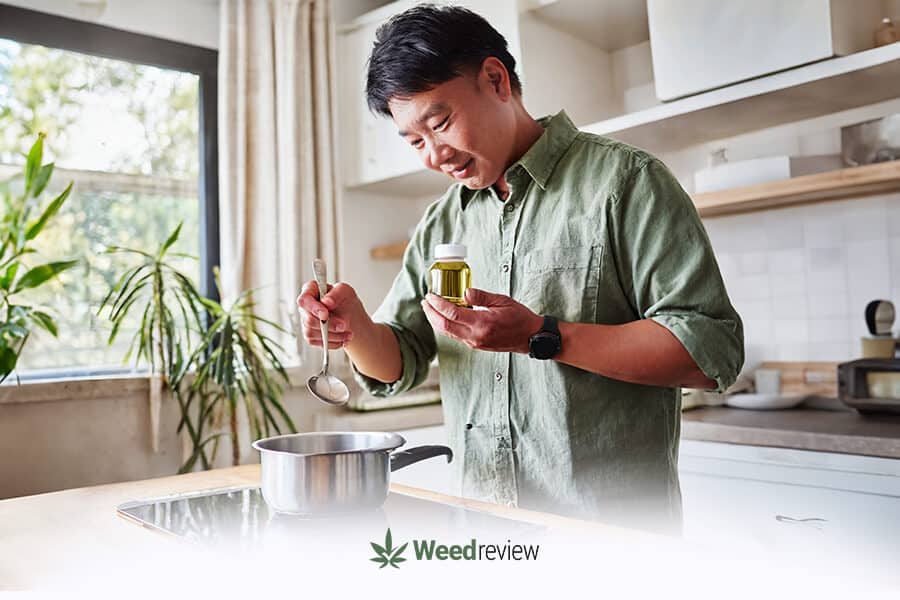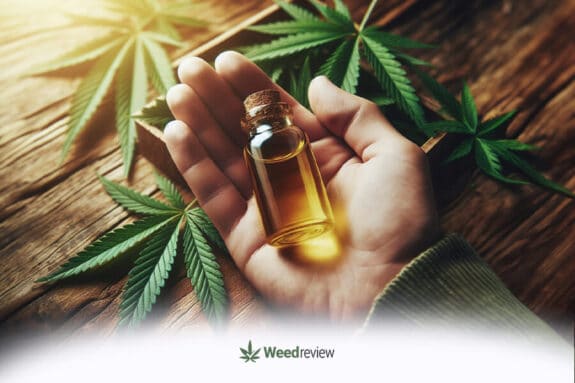
CBD Oil Recipe: A Step-by-Step Guide to Make CBD Oil at Home

Table of Contents
Medical marijuana patients in Thailand use CBD oil for its health benefits, like pain management, anxiety relief, and managing epilepsy symptoms. While buying CBD oil from licensed dispensaries is an option, some patients prefer to make their own oil at home for more affordable and customised treatment.
Cooking cannabidiol oil at home is like cooking the Thai soup, Tom Kha Gai. Both need careful simmering and the right mix of ingredients to get the best results.
This article will teach you everything you need to know to make your CBD oil at home. We will look at the ingredients you need, the steps to follow for a proper brew, and common mistakes to avoid.
List of ingredients for making CBD oil
Like with any dish, you first need to gather the ingredients. In the case of CBD oil, you will need to focus on two primary items: a suitable carrier oil and hemp flower. The two are discussed in detail below.
Carrier oils: Which ones to use?
Carrier oils play a crucial role in homemade CBD oil. They serve as the base in which the cannabidiol, along with other beneficial cannabinoids, gets dissolved. The most common ones are mentioned below.
Coconut oil
- What is it? A light oil with fats that are good for our bodies.
- Why use it? It can soak up a lot of CBD and has a soft taste. Great if you’re giving CBD oil a first go.
- Who’s it for? Newbies or anyone after a gentle-tasting oil.
Olive oil
- What is it? A well-known oil that is rich in antioxidants.
- Why use it? It has a long shelf, and its taste is a bit fruity. It can also boost CBD’s healthy effects and complement its anti-inflammatory properties.
- Who’s it for? Folks who like a hint of fruit in their oil or want the product to last a bit longer.
Hemp seed oil
- What is it? An oil from the same plant as CBD.
- Why use it? It has a nutty taste and is jam-packed with omega fatty acids and nutrients.
- Who’s it for? Those who fancy a proper cannabis taste or want some extra health perks.
By using the carrier oil method, you’re not just extracting CBD but also other valuable cannabinoids and terpenes from the cannabis plant. As a result, you get a full-spectrum product which supports the “entourage effect,” thereby leading to a broader range of health benefits.
Activating your CBD: Why decarboxylation matters before cooking?
Before you start extracting CBD, you must decarb your weed. This is the act of gently heating the cannabis to activate the CBD compound, making it more bioavailable for our bodies.
Why decarboxylate? Raw cannabis contains CBDA, a precursor to CBD – and our body is not great at absorbing CBDA. If you start cooking without decarboxylation, you will end up with an earthy-tasting oil which will not deliver any of the benefits you seek.
Heating the hemp/CBD flowers converts CBDA into CBD – which is what our body can absorb.
Choosing the correct strain
The cannabis strain you choose can drastically influence the potency and effectiveness of your CBD oil. Opt for hemp flowers, known for high CBD percentages. A popular choice is Charlotte’s Angel, but many other CBD strains are also available.
Important:
Hemp flowers, while rich in CBD, can also contain trace amounts of THC. When extracting oil from these flowers, the resulting product may contain THC. It's crucial to be aware of this, especially if you're concerned about drug testing or THC sensitivities.
Tools and ingredients needed
- 14 grams of high-quality CBD flower
- 250 ml coconut oil/preferred carrier oil
- 1/4 teaspoon of mint extract (optional)
- A saucepan
- A stainless steel bowl
- A cooking thermometer
- A cheesecloth or fine strainer
- Storage container
This recipe will yield approximately 250 ml of CBD oil of mild potency. If you need to make more, you can easily scale up the recipe by keeping the same ratio of 1:18. This means for every gram of CBD flower, you will use 18 ml of oil.
For a more concentrated, potent oil, you might aim for a 1:6 ratio, meaning for every gram of CBD flower, you’d use 6 ml of oil.
CBD oil recipe

- Grind the flowers:
- Take the CBD flower and grind it finely using a grinder. Grinding increases the surface area exposed to heat, ensuring a more efficient and even decarboxylation.
- Decarb:
- Preheat your oven to approximately 110°C. Spread the finely ground CBD flower evenly on a baking sheet and place it in the oven for 40–50 minutes. This process activates the CBDA molecules, converting them to CBD.
- Start the infusion:
- In a saucepan, combine the coconut oil with the decarboxylated flower. Gently stir until the oil melts and blends thoroughly. Gradually bring it to a low simmer; rapid heating can lead to burning.
- If using a double boiler, put your oil and hemp flowers in a bowl. Set this bowl over a saucepan of simmering water. The steam heats the mixture, preventing burns. Keep stirring until blended well.
- Simmer the mixture:
- Allow the mixture to infuse for 4–6 hours, periodically stirring. Using a cooking thermometer, maintain the oil’s temperature between 70°C and 85°C to preserve the cannabinoids and terpenes. Adjust the heat if necessary.
- Strain the oil:
- Once simmered, remove from heat and let the mixture cool for a bit. Strain the oil into a glass container using a cheesecloth or strainer, ensuring that the final product is free from plant residues.
- Storage:
- Transfer your CBD oil to an airtight container and store it in a cool, dark place. When stored correctly, the oil remains viable for up to two years.
- Quality check:
- To evaluate your homemade CBD oil’s quality, inspect its clarity. A high-quality CBD oil should be clear and not dark, with no presence of plant material in it.
Calculating dosage for homemade CBD Oil
Understanding the dosage of your homemade CBD oil is crucial to get the desired effects without overdoing it. Here’s a comprehensive guide to help you determine the potency of your CBD extract:
- Determine the CBD potency of your flower: Typically, the CBD content is listed as a percentage. For example, if the label on the Remedy strain at your local dispensary says 20%, it means that there’s 20% or 200mg of CBD in every gram of the bud.
- Calculate total CBD content: Using the recipe provided as an example, if you use 14 grams of a flower with a 20% CBD content, the total CBD in the recipe would roughly be 2,800 mg (14 grams multiplied by 200 mg).
- Calculate CBD concentration in the oil: Using the above example, divide the total CBD content (2,800 mg) by the total volume of your oil (250 ml). This gives a concentration of 11.2 mg of CBD per ml. So, if you consume 1 ml of the oil, you’re ingesting 11.2 mg of CBD.
- Adjust according to your flower: The potency of your oil will vary based on the CBD content of the flower and the amount of oil you use. So, repeat this calculation every time you switch to a new strain or batch. For a more potent formulation, reduce the amount of oil you are using or increase the amount of flowers.
Tips for making high-quality CBD tincture at home
For the best results and safety, keep these expert recommendations in mind:
- Avoid mouldy cannabis: Never use flowers that have developed mould for CBD extraction. Ingesting or inhaling mould can be harmful since it can produce toxic compounds called mycotoxins.
- Choose the right storage: Store your homemade CBD oil in a dark-coloured, airtight container to increase its shelf life. Glass containers with tight-sealing lids are ideal as they prevent chemical leaching and protect the oil from light and air.
- Ensure good ventilation: The process of making CBD oil can produce strong odours. Make sure to cook in a well-ventilated space; open windows or use exhaust fans to maintain air quality.
- Consider essential oils: For enhanced effects, especially in topicals, you can introduce essential oils. For example, adding lavender can augment the calming and anti-inflammatory properties of your product.
- Consider adding flavour: CBD extracts on their own may not taste great. When cooking a batch at home, you may add small amounts of flavouring extracts like orange, vanilla, or mint.
Refining your CBD oil
For a more potent and purer product, consider refining your CBD oil through winterization:
- Freeze the oil: Place the container with your CBD oil in the freezer for a full 24 hours. This step solidifies impurities, making them easier to separate.
- Filter out impurities: After freezing, pour the oil through a coffee filter or cheesecloth. This will capture the solidified waxes, lipids, and other unwanted components, leaving you with a cleaner oil.
- Reheat gently: Warm the filtered oil in a saucepan over low heat. There’s no need to bring it to a boil — just warm it enough to restore clarity. Once reheated, your refined CBD oil is ready for use, free from unnecessary waxes and lipids.
How to use CBD oil
Using CBD oil is straightforward, but dosage and method can impact its effectiveness:
- Dosage: Start with a small dose (often 5-10mg for beginners) and gradually increase until you find what works best for you.
- Sublingual use: Place the desired amount under the tongue and hold for 60-90 seconds before swallowing. This method allows for faster absorption.
- Topical application: CBD oil can also be applied directly to the skin for localised relief.
- Ingestion: You can mix CBD oil with food or drink, but absorption might be slower than the sublingual method.
What are the benefits of CBD oil?
CBD oil has gained popularity for a range of potential health benefits, including:
- Alleviating symptoms of anxiety and depression.
- Supporting better sleep.
- Reducing pain and inflammation.
- Promoting heart health.
- Aiding in substance misuse treatment.
- Potentially reducing symptoms related to cancer treatments.
Side effects of CBD oil
While CBD has been deemed relatively safe to consume, there are always side effects as a result of improper dosing and poorly cooked batches. Here are the most common side effects of using CBD oil:
- Dry mouth
- Drowsiness or fatigue
- Reduced appetite
- Diarrhoea
- Potential interaction with other medications
- Mild nausea
- Changes in mood and perception
- Low blood pressure
- Light-headedness or dizziness
CBD oil can also interact with other medications by affecting how your body processes these drugs. This drug interaction can be bad for you, especially if you are taking prescription medicines regularly.
To lower the chance of any side effects and get help in finding the right dosage, consult with your doctor.
Is it legal to cook CBD oil at home in Thailand?
Thailand has decriminalised the use of cannabis, including CBD oil. As of 2023, it is legal to buy, sell, and consume CBD oil and hemp flowers within the country.
The same also holds good for cooking with CBD flowers. You can cook CBD oil at home for personal use. If you want to do it for commercial reasons, that is, if you want to sell your tinctures in the market, you will need the necessary licenses from the Thai authorities.
Conclusion
Making your own CBD oil can be a rewarding and affordable way to improve your health and wellness. It is a very straightforward process – mix the carrier oil with decarboxylated hemp flowers for 4-6 hours on low heat and filter.
You can experiment with different carrier oils and CBD strains to add some variety to your fitness routine. Similarly, you can tweak the potency of your tincture by changing the amount of oil, flowers, and the potency of the bud. Be mindful that the end product may contain some THC in it – but not enough to produce psychoactive effects.
For best results, follow the steps mentioned in this CBD oil recipe – give extra attention to filtering and winterisation to improve the quality of your end product.


